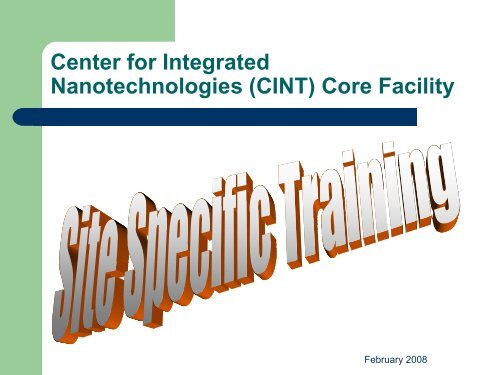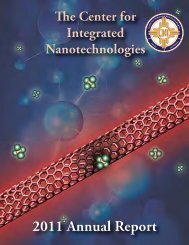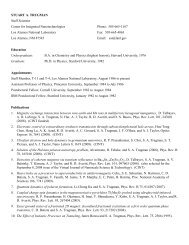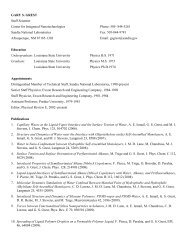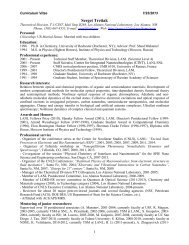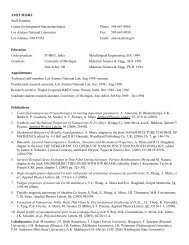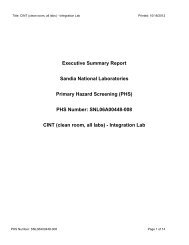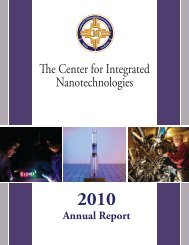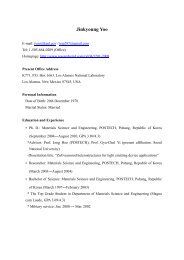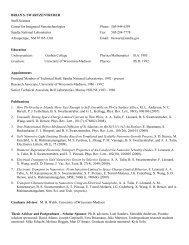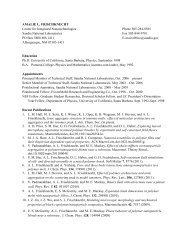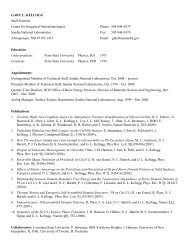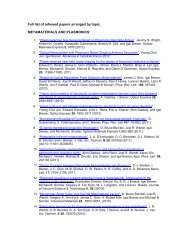(CINT) Core Facility - Center for Integrated Nanotechnologies
(CINT) Core Facility - Center for Integrated Nanotechnologies
(CINT) Core Facility - Center for Integrated Nanotechnologies
- No tags were found...
You also want an ePaper? Increase the reach of your titles
YUMPU automatically turns print PDFs into web optimized ePapers that Google loves.
Topics• Location & Layout• BadgesSecurity• Roles & Responsibilities• Foreign National Escorting/Monitoring• Prohibited Items• Wireless Networks• Hazards and Mitigations• Training• Emergency Response• Contact In<strong>for</strong>mationFebruary 2008
Location and Layout• SNL/NM (DOE leased land)• North of Kirtland Air Force Base (KAFB),west of Eubank Gate• Comprised of three wings: CharacterizationLabs, Synthesis Labs, Integration Labs• Staff offices, chemical storage room, loadingdock areaFebruary 2008
CharacterizationLaboratoriesConf. Rm. 1028Chaco WestConf. Rm. 1026Chaco EastConf. Rm. 1024Casa RiconadaChaco 1022(Breakroom)North Office Pod(Staff Offices)Conf. Rm. 1151Fajada Butte N.SynthesisLaboratoriesNorth Wedge(User Offices)South Wedge(User Offices)RestroomsConf. Rm. 1351Fajada Butte S.Conf. Rm. 1021Pueblo Bonito N.EntryRestroomsConf. Rm. 1425Exec. Pueblo AltoConf. Rm. 1041Pueblo Bonito S.Executive Office Pod(Staff Offices)South Office Pod(Staff Offices)Integration LaboratoryClass 1000 Clean Room
CK00001U. S. Department of EnergyAlbuquerque Operations OfficeCK00033Sandia National LaboratoriesAlbuquerque, New MexicoQBadgesVIRGINIA S.FOSTERW YCVIRGINIA S.FOSTERIS: 12/31/98EX: 12/30/99BRAZIL• All Sandia personnel, resident contractors, andvisitors will wear SNL photo identification badges atall times in Building 518.• Visitors that are visiting the <strong>CINT</strong> <strong>Core</strong> <strong>Facility</strong> <strong>for</strong>three days or less need to wear a numbered SNLBuilding specific visitor badge and must sign thevisitor’s log.• Foreign National Visitors must obtain badges fromthe badge office.February 2008
Where can I go?• Entry into all areas of the <strong>CINT</strong> <strong>Core</strong> <strong>Facility</strong>is through the use of badge readers.• Access to areas depends on businessneeds.February 2008
Foreign NationalEscorting/Monitoring• Definition of a <strong>for</strong>eign national (FN): Any person who is not a citizenof the U.S., is not a lawful permanent resident, and is not a protectedindividual. FNs must wear a Sandia specific uncleared red badge.• All FNs must be escorted in the office pods at the <strong>CINT</strong> <strong>Core</strong><strong>Facility</strong>– When a FN is escorted into one of the office pods, the escort must remainwith the FN at all times until the escort responsibility is transferred tosomeone else within the office pod or the FN exists the office pod.• FNs do have to be escorted but should be monitored in all otherareas besides the office pods in the <strong>CINT</strong> <strong>Core</strong> <strong>Facility</strong>.Responsibilities typically include:– Ensuring FNs are aware of and restricted to authorized scopes of work andspecified visit locations (e.g. buildings and rooms)– Maintaining an awareness of what FNs are doing by periodically checkingtheir work and requesting feedback regarding their activitiesFebruary 2008– Periodically checking on the FNs’ whereabouts
Prohibited itemsSandia National Laboratories is a drug-free and a tobacco-free environment. The use orsale of tobacco products on Sandia controlled property is prohibited. Sandia propertyincludes SNL vehicles, building interiors, exteriors, entryways, walkways, parking lots,fenced areas, interior of personal vehicles parked on Sandia controlled property, andportions of buildings controlled by Sandia.‣Additionally, visitors must not bring the items below into the <strong>CINT</strong> <strong>Core</strong> <strong>Facility</strong>– Alcohol and alcoholic beverages– Controlled substances (illegal drugs and associated paraphernalia)– Explosives, flammables, radioactive materials, or chemicals– Firearms, weapons, or incendiaries– Any other items prohibited by law– Laptops with camera capabilities– Cellular telephones with camera capabilities– Radio frequency transmitting equipment– Audio, video, optical, and data recording devices (i.e. non Sandia-owned BlackBerrys;all iPods and MP3 players.)Questions? Contact your Sandia host.February 2008
Wireless Networks• Thunderbird (T-bird) Network – provides access to theSandia Restricted Network (SRN). General SRN access is onlyavailable to employees, and on-site contractors, who are U.S.citizens or lawful permanent residents from non-sensitivecountries, per<strong>for</strong>ming Sandia-directed work. A crypto card andVPN client software are required.• Sandia Hotel Network (SHN) – provides guests of Sandiaaccess to the Internet while visiting the site. A username andpassword are required. Access is granted to visitors, includingindividuals who are lawful permanent residents from sensitivecountries or are non-resident alien <strong>for</strong>eign nationals. Sandiansare not allowed to have a SHN account.• When you are not on the network, please make sure to turnyour wireless card off so it does not try to connect to otherrestricted wireless networks at the facility.February 2008
Hazards associated with <strong>CINT</strong> <strong>Core</strong><strong>Facility</strong>• Chemicals• Lasers• Non-ionizing radiation• Biological• Pressure/Thermal/ElectricalFebruary 2008
Chemicals• Training– LAB100 <strong>for</strong> Members of the Work<strong>for</strong>ce who engage inactivities that involve potential exposure to hazardouschemicals.– The OSHA Lab Standard requires that Members of theWork<strong>for</strong>ce are trained in measures they can take to protectthemselves from exposure to hazardous chemicals,including emergency procedures.• Signage– The Sandia Workplace Hazard Awareness System(SWHAS) is used to identify hazards within a laboratory.February 2008
Chemicals (continued)• Purchasing– At SNL/NM, chemical substances should be purchasedthrough the SNL Just-in-Time (JIT) chemical supplier. TheJIT system automatically affixes a tracking barcode label tothe chemical container so that the chemical is immediatelyentered into the SNL inventory with an appropriate MSDS. Ifat anytime a chemical container needs a barcode label, callthe CIS/NM Helpline at 844-MSDS <strong>for</strong> bar-coding serviceand other CIS related questions.• Chemical Hygiene Program (CHP)– Sandia's CHP is Chapter 6E of the ES&H ManualFebruary 2008
Chemicals (cont’d)• Technical Work Documents (TWDs)– Sandia uses Technical Work Documents (TWDs) likeSOPs and OPs that describe safety and healthconsiderations when laboratory work involves theuse of hazardous chemicals, including particularlyhazardous substances• Housekeeping– Keep work area clean and organized. Storechemicals properly when not in use and at the end ofthe workday.February 2008
Hazardous Waste• Training applies to all Members of the Work<strong>for</strong>ce at SNL/NMwho generate, treat, store, or request disposal of materialidentified as hazardous waste. (ENV112)• At SNL/NM, you are a Hazardous Waste Generator if yourwastes must be managed in accordance with the requirementsof the ES&H Manual, Section 19A.• The SNL/NM Chemical In<strong>for</strong>mation System (CIS) trackschemicals or chemical products from purchase to disposal. TheCIS can help you locate an MSDS <strong>for</strong> your chemical waste.February 2008
Lasers, Nonionizing Radiation andBiological• Lasers– Laser101I (Introduction)– Laser200B (Class 3b or 4 lasers)– Requirements in Section 6G of the ES&H Manual• Nonionizing Radiation– Energy in the electromagnetic spectrum with wavelengths between106 centimeters (cm) (extremely low radiofrequency) to 10-5 cm(ultraviolet light) and with frequencies between 0 megahertz (MHz)and 3 x 105 MHz.• Biological– Biological Activities (BIO105)– Requirements in Section 6N of ES&H ManualFebruary 2008
Electrical• Due to the nature of research, the risk of electric shock is greater in anR&D laboratory than most other work environments.• Electrical energy is uniquely dangerous because electricity is invisible,survival of mild shock is misleading and the use of electrical energy iswidespread.• To per<strong>for</strong>m work safely, each individual must follow all applicableprocedures, properly use personal protective equipment, and completerequired training.• When working in the laboratory, you should know the location of firealarm pull-boxes, emergency shut down buttons, and emergencyeyewashes and showers.• Operating procedures, warning devices, signs, personal protectiveequipment, and training are controls used to minimize electricalhazards.• It is very important to report all electrical shocks.February 2008
Pressure Hazards• Pressure Installer– Personnel responsible <strong>for</strong> installing, modifying, or procuring pressure hardwarewithout supervision. Pressure installers can also supervise the activities of non-pressure installers who may be per<strong>for</strong>ming installation or modification tasks.• Pressure Operator– Anyone who uses or operates pressure systems. Pressure operators do not modify orinstall pressure hardware, with the exception of routine operations ons such as changinggas cylinders and regulators.– Responsibilities and limitations• Hazard awareness• Knowledge of the assembly• Assistance available• Familiar with documentation– Operator Limitations• Routine operation only (may include routine cylinder changes, loadingsamples, etc.)• Can not design or install new systems or re-configure existing systems• Hardware training required commensurate with responsibilitiesFebruary 2008
Pressure Safety Data Package (PSDP)Documentation• Documents compliance with manual - hardware ratings, etc.• Is a working document which is kept current• Contains all in<strong>for</strong>mation needed <strong>for</strong> future evaluations• Used as a training tool <strong>for</strong> operators• May refer to start-up, operating, shutdown procedures(checklists, operator aids).• Signatures = Installer / Operators / Pressure Advisor / ManagerFebruary 2008
Gas cylinders• Gas cylinders are stored and handled in accordance withregulations– Proper storage & separation, secured, and proper identification– Gas cylinder cart with safety chain and with cylinder valveprotection cap in place• Gas cylinders shall be properly identified– Gas ID label and CIS bar code (no color code)– DOT markings / DOT test date• Gases are ordered through the JIT contract (Matheson TriGas)– CIS bar codes and delivery to point of use– 3 rd party gases can be ordered JIT– Return cylinders to the supplier (mark <strong>for</strong> pick up)February 2008
Cryogens• Cryogenic liquids are gases that have been trans<strong>for</strong>med intoextremely cold liquids which are stored at low pressures inspecially constructed, multi-walled, vacuum-insulatedcontainers.• Common cryogen hazards:– Thermal (Freezing)– Pressure Build-up– Brittle Materials– Ice Build-up– Asphyxiation / O2 deficiency– Oxygen Enrichment– Noise– Back strain / liftingFebruary 2008
Other Hazards to consider…• Theft/car break-ins/personal safety• Slips, trips, and fallsFebruary 2008
Hazard Mitigation• Individual Primary Hazard Screening (PHSs) <strong>for</strong>each laboratory• Each laboratory has associated Technical WorkDocuments (TWDs)• All personnel working in laboratories shall read theappropriate TWDs and provide a signature notingthat the documents have been read.• Training shall be completed prior to conductingoperations in a laboratory.February 2008
Hazard Mitigation (continued)• If valuables are left in your vehicle, don’tleave them in view of passer-bys.• Be vigilant when exiting the facility.• Stay on the sidewalk, watch <strong>for</strong> curbs and beespecially careful during inclement weather.February 2008
Training• Required training– <strong>CINT</strong>100– ESH100• Other– Lab specific training coursesFebruary 2008
Emergency Response• For all incidents call the non-emergency hotline(311).• For emergency situations, call 911 (or 844-0911from a cell phone).• In the event of a fire alarm please exit the <strong>Core</strong><strong>Facility</strong> and proceed to the assembly area located inthe east parking lot, unless otherwise instructed.• Chapter 15 of the SNL ES&H Manual describes therequired and recommended actions to be taken byMembers of the Work<strong>for</strong>ce when an emergencycondition is observed or experienced at SNL.February 2008
Fire extinguishersFire Alarm Pull BoxesFire Extinguishers andFire Alarm Pull BoxesLocator
EXITLocation of EXITsEXIT LocatorEXITEXITEXITEXIT
EmergencyEmergencyAssembly AssemblyArea AreaFebruary 2008
Important numbers to remember• 911 <strong>for</strong> emergencies (844-0911 from a cell phone)• 311 <strong>for</strong> non-emergencies• <strong>CINT</strong> <strong>Core</strong> ES&H Coordinator:– Mike Starr• Phone: 844-0046• Pager: 530-0885• <strong>CINT</strong> SNL Gateway (aka Building 897) ES&H Coordinator:– Wayne Davis• Phone: 844-6734• Pager: 540-1798• <strong>CINT</strong> Receptionist:– Sandy Pino-Lucero• Phone: 844-3286February 2008
For questions please contact:Mike Starr, 844-0046, mstarr@sandia.govFebruary 2008


